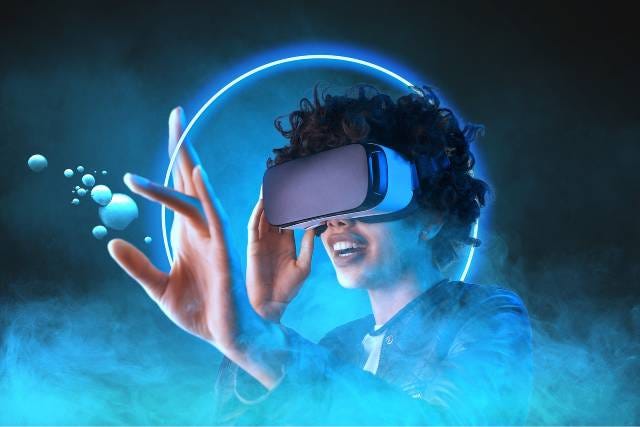Imagine walking into an art gallery and seeing a painting come to life. Augmented reality (AR) makes this possible; it’s no longer just science fiction. AR is transforming how we interact with art and design by combining digital components with physical reality to create immersive experiences. From mobile apps that enhance street murals to interactive museum exhibits, AR is transforming creativity as we know it. Reality and fantasy are merging, allowing artists and designers to explore new avenues of expression. Are you ready to dive into this exciting development? Let’s take a look at how augmented reality can change the future of creative scenes!
How AR Is Changing the World of Art and Design
Augmented reality is changing the way designers and artists interact with their audiences. AR creates immersive experiences that engage people by layering digital materials over the physical environment. Artists can now present their work in multiple dimensions. Imagine seeing a work of art come to life before your eyes. This technology transforms static art into dynamic stories by adding dimension and storytelling.
AR enhances product visualization capabilities for designers. Virtual models allow customers to interact with designs, allowing them to quickly comment and make changes. It effortlessly bridges the gap between ideas and reality. Public projects also benefit from the potential of AR. Interactive sculptures or murals encourage viewers to actively participate rather than passively watch. The ease of use of these tools has stimulated collaboration between disciplines, leading to reinventions of traditional techniques and new trends in creative fields.
The Impact of AR on Traditional Art Forms
Augmented reality (AR) is changing the way we interact with traditional art forms. Artists can now overlay digital components on physical objects to create an immersive experience that blurs the lines between reality and fantasy. Imagine walking through a gallery and watching paintings come to life. The tones change, the characters move, and the story unfolds before your eyes. This dynamic engagement re-engages audiences who previously felt alienated by traditional media.
AR also opens up new possibilities for narrative in installation art and sculpture. Viewers can discover secret stories or complex mysteries beneath the surface. This technology also allows artists to reach more people. By promoting appreciation for different cultures, people from all over the world can enjoy local art without ever setting foot in a gallery. At the same time, some purists worry about the loss of authenticity in the mix of the digital and physical domains. Arts organizations around the world are still angry about these tensions.
Difficulties and Controversy
Augmented reality art and design also have their challenges. Accessibility is a major issue. Not everyone has the technology to fully enjoy augmented reality. Then there is the question of authenticity. Some traditionalists believe that mixing digital elements with tangible artworks damages the value and essence of the artwork. They fear that it obscures the original ideas of the artist.
There can also be issues with intellectual property, especially when AR overlaps existing works without permission. In a world where digital customization has become easy, artists are struggling to protect their work. What’s more, there’s still much debate about its impact on audience engagement. Does AR distract people from things or enhance their appreciation? Opinions vary widely on this ever-changing field, which reflects a general debate about art itself in our technology-driven society.
The Future of AR in the Creative Field
The future of augmented reality in the creative field is full of potential. Using augmented reality, artists are creating immersive experiences that merge both reality and fantasy. Imagine walking through an art gallery, standing in front of paintings that come to life, and listening to their stories. This engagement not only brought joy to people but also strengthened their connection to art.
Designers are increasingly integrating augmented reality into their processes, allowing clients to see ideas in real time. This technology enables rapid feedback and changes, making collaboration easier than ever before. As AR continues to evolve, we can expect a plethora of creative tools that empower artists in all disciplines. Seminars can become dynamic learning spaces full of interactive features. There are great opportunities for education and community engagement.
Conclusion
Dynamic Boundaries is the intersection of augmented reality and art. Artists now have unprecedented opportunities to expand their creativity. AR allows users to interact with art in an engaging way and be captivated by it. Designers can merge the digital and physical worlds to create interactive features that engage audiences in creative ways. This technology blurs the traditional boundaries of creative forms, making collaboration between artists easier.
AR will continue to evolve, and we will see more and more revolutionary applications in private collections, public spaces, and museums. The possibilities for storytelling using stacked images are incredible. As we embrace these developments, we also embrace changes in our perspective and engagement with the art form. It encourages everyone—artists, designers, and spectators—to explore new aspects of creation together.
FAQs
1. What is augmented reality?
Augmented reality (AR) uses technology such as smartphones or AR glasses to combine digital components with the real world. This allows users to see virtual images superimposed on their real-world surroundings.
2. How can augmented reality help artists?
AR provides artists with the tools to enhance their stories, allowing them to create multidimensional experiences that are more interactive than traditional media.
3. Are there any notable examples of AR in museums?
Absolutely! Many museums are using augmented reality (AR) applications that can transform static displays into active experiences or provide visitors with more information about an artwork. This gives visitors special insights that they cannot get from labels alone.
4. What challenges does an artist face when using augmented reality?
The challenge lies in making digital works accessible to different audiences and maintaining their uniqueness, despite rapid technological developments.
5. Will AR replace traditional art forms?
While others question this change, it is more likely that AR will coexist with traditional practices. AR will enhance rather than replace these practices by offering new opportunities for interaction and discovery within art.




